CBSE NotesCBSE Notes Class 6 ScienceNCERT Solutions Science
CBSE Class 6 Science Notes Chapter 16 Garbage In Garbage Out Pdf free download is part of Class 6 Science Notes for Quick Revision. Here we have given NCERT Class 6 Science Notes Chapter 16 Garbage In Garbage Out.
CBSE Class 6 Science Notes Chapter 16 Garbage In Garbage Out
Dumping of wastes: We sweep houses, shops and other places, collect the dirt and other waste materials in the polythene and throw it either in a drain or at the comer of the street.
The heaps of rubbish material not only spread dirtiness but also provide shelter to houseflies, mosquitoes, microorganisms, bacteria and other disease-carrying living organisms.
Hospital waste includes bandages, cotton impulse, injection bottles, tablet wrappers, cut out plaster, syringes, glucose bottles, needles, papers, corks, instruments, tubes, fruit peelings and seeds.
Mostly wastes are used for filling the low lying areas. These things pollute the soil and are responsible for several fatal diseases.
Many people sort out syringes, tubes, needles and other reusable instruments, wash them and reuse them which become the cause of many diseases.
The filling materials diffuse in the soil and pollute the soil.
Dustbins: The utensil or space where the waste material is collected is called dustbin.
Green dustbins: Generally we use green dustbin for collecting biodegradable waste.
Blue dustbins: The non-biodegradable wastes which do not decompose naturally are kept in blue dustbin.
Biodegradable waste: The waste matter which is decomposed by microorganisms naturally is called biodegradable waste.
Non-biodegradable waste: The waste matter which is not decomposed by micro-organisms is called non-biodegradable waste.
The edible wastes which are thrown by people in the -polythene bags and eaten up by cow, pig, dog, etc., are not digested in their alimentary canal as a result of which the cattle become patients.
Polythene and plastics are very useful in our lives but are non-biodegradable.
Unnecessary use of plastic and polythene should be checked.
We should try to use paper and jute bags as much as possible.
3‘R’: We should use 3‘R’ for checking the increase of waste matter. The first ‘R’ means ‘Reduce’. The meaning of the second ‘R’ is ‘Reuse’ and the meaning of the third ‘R’ is ‘Recycling’. We should use things in maximum which are biodegradable.
Waste material: Every person creates rags and throws all those things which he has used once and does not use it again. These things are commonly called waste materials.
Landfill: Waste material, faeces of animals, kitchen waste, garden waste, etc., are collected in dustbins from where it is thrown out into the low lying areas for filling a purpose.
Compost: The manure made up by kitchen wastes and garden wastes is called compost manure. It increases the fertility of the soil.
Vermicomposting: Method of preparing compost with the help of redworms is called vermicomposting (Fig.).
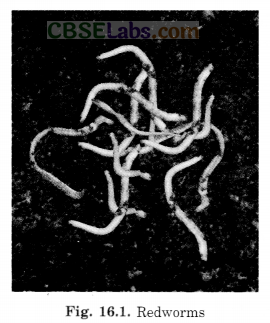
Garbage: All the used or unusable substances which cannot be reused in the same form is called garbage.
Recycling: It is a process in which a material which has been used once is recycled to produce something to reuse.
Segregation Of Wastes
Garbage or waste may be in the form of fruit or vegetable peels, discarded objects, wrapping materials, wasted food as household garbage, or discarded chemicals and fertilizers washed into rivers, domestic sewage, etc. These wastes can be segregated into biodegradable and non-biodegradable. Wastes that rot (undergo degradation) by the action of decomposers (tiny organisms found in the soil) are called biodegradable wastes. Dead plants and animals and their products (e.g., fruit and vegetable peels, paper, and leaves) decay very easily These wastes mix with the soil and produce manure. Wastes that do not rot by the action of decomposers are called non-biodegradable wastes. For example, glass, plastic, and metals. Many of them can be recycled to produce new things.
Depending on the type of wastes, two garbage bins—one for biodegradable wastes and other for non-biodegradable wastes should be used. This will help in easy sorting and recycling of wastes to make beneficial products.
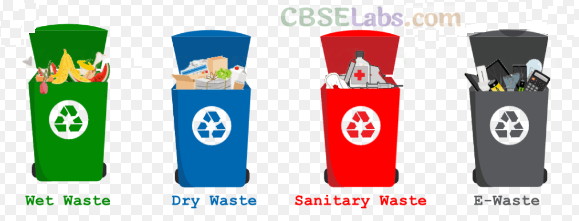
Best out of waste
The Rock Garden in Chandigarh is an excellent example of how solid wastes can be utilized. Every item in this garden is made from waste materials like tyres, plastic bottles, eggshells, and tube lights. This innovative idea of utilizing solid waste has made the Rock Garden very popular tourist attraction.
Management Of Biodegradable Wastes
Some of the ways to manage biodegradable wastes are as follows:
Composting:
Since biodegradable or organic wastes like vegetable peels, waste food, leaves, dead flowers, and egg shells can be recycled, they are converted into manure by burying them in compost pits. Recycling of organic wastes like vegetable peels, waste food, leaves, etc., by burying them in compost pits is called composting. Composting is a simple and almost effortless process of recycling. The biodegradable wastes are degraded by the action of small organisms like bacteria and fungi. There is also a different kind of composting where a kind of earthworm called red worms (or red wrigglers) act on wastes and degrade them.
This type of composting with the help of a type of earthworm called red worms, is called vermicomposting (Fig. 17.1). Red worms break down the organic matter into nutrient-rich manure which increases soil fertility.
Vermicompost can be made in 3-4 weeks and it appears as loose soil-like material. One should not put animal product or oily substance in the pit as it could lead to the growth of disease-causing organisms.
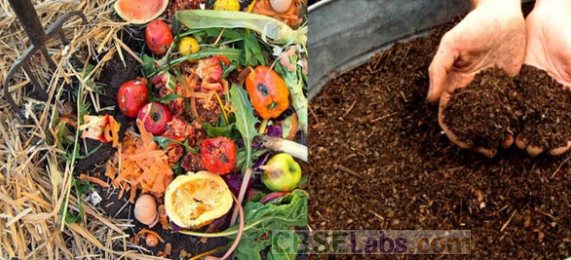
Landfills
Large areas used for waste disposal are called landfills. The landfill is another method to manage a huge amount, of biodegradable waste. In a landfill, garbage is buried in such a way that it does not damage the environment (Fig. 17.2). Garbage buried inside landfills stay here for a long time as it decomposes very slowly. After a landfill is full, it can be converted into a park. For example, Indraprastha Park in New Delhi is built on a landfill site.
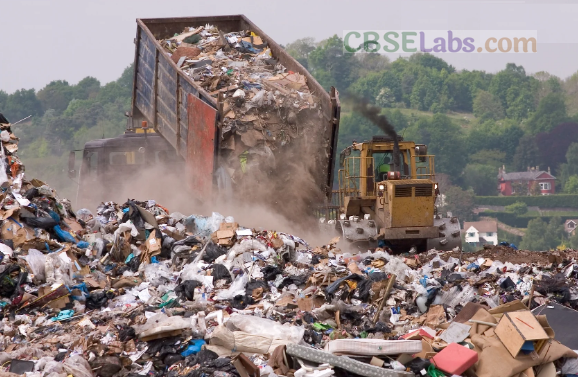
Management Of Non-Biodegradable Wastes
As non-biodegradable wastes like plastic bags, glass bottles, etc., cannot be broken down by decomposers, their disposal poses a big problem.
Non-biodegradable wastes can be managed by practising the concept of 3 Rs—Reduce, Reuse, and Recycle.
Reduce
We need to reduce the amount of waste generated by consuming more and throwing away less. We often buy more things than we really need. Nowadays, disposable items have become popular, for example, ballpoint pen, plastic bag, disposable napkins etc. We are using them frequently without giving a thought to their hazardous effects.
Here are some tips for reducing wastes:
- Use a fountain pen in place of a ballpoint pen,
- Use old newspapers for packaging, and
- Use cloth napkins in place of disposable ones.
Reuse
We can reuse certain things for more than one purpose. If we reuse them for other purposes, we can help in reducing waste. Here are some of the tips for reusing things:
- Small jars and bottles can be cleaned to keep some other kitchen stuff.
- One should prefer glass bottle to metal can when buying juice or soft drink. The bottles can be refilled.
- Old clothes can be made into other usable items like cushion cover, handkerchief, etc.
- Old mobile phones can be donated to friends or family.
Recycle
The process by which waste materials are used to make new products is called recycling. Materials like glass, metal, plastic, and paper are collected, separated, and recycled to make new things.
Recycling of Plastics
Bucket, bottle, toy, shoe, bag, pen, and comb are a few things made of plastic. Use of plastics has become a major concern nowadays because they are non-biodegradable and release harmful gases upon heating or burning. They can also contaminate foodstuffs. If eaten by animals, plastics can choke and kill them. Therefore, one should reduce and reuse plastic items as far as possible. When plastic items are to be discarded, they should be recycled to make new things.
Not all the plastics generated are recycled, hence causing much damage to life on Earth. In many places in India, plastics are totally banned seeing its adverse effects on the environment.
Some of the ways to reduce, reuse, and recycle plastics are as follows:
- Paper, cotton, and jute bag should be preferred over plastic bags (Fig. 17.4).
- Some disposable plastic containers and jars can be used to grow plants (Fig. 17.5).
- Empty bottles can be refilled for storage of water or any other liquid stuff. Think about the number of times you buy a bottle of water when you are out. Instead, you can fill the used bottle and carry it whenever you are out.
- Zip foils can be reused after cleaning thoroughly each time after storing foodstuffs.
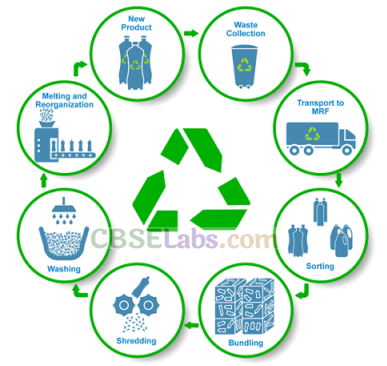
Recycling of paper:
Paper is made from trees and trees are essential for our survival on Earth. So, even if paper is biodegradable, depletion of trees at a fast pace is a big concern. Therefore, to save trees we must use paper carefully. Some of the ways to save paper are:
- We should always write on both sides of paper sheets.
- Unused pages from old notebooks can be torn off and made into a new notebook for doing rough work and other miscellaneous work.
- We can also reuse envelopes and covers by using stickers to write new addresses.
- We can also make fresh paper from old newspapers.
By now, we know how harmful garbage accumulation can be. But, by following the 3Rs concept, we can manage the garbage generated in our surroundings so that it is beneficial to the environment.
Biodegradable wastes: Wastes that rot by the action of decomposers are called biodegradable wastes.
Non-biodegradable wastes: Wastes that do not rot by the action of decomposers are called non-biodegradable wastes.
Composting: Recycling of organic wastes like vegetable peels, waste food, leaves, etc., by burying them in compost pits is called composting.
Vermicomposting: Composting with the help of a type of earthworm, called red worms, is called vermicomposting.
Landfills: Large areas used for waste disposal are called landfills.
Recycling: The process by which waste materials are used to make new products is called recycling.
There are mainly two types of wastes based on their ability to rot over a period of time: biodegradable and non-biodegradable wastes.
Dead plants and animals and their products decay while objects like plastic and glass do not.
Vermicomposting and landfills are two ways of managing solid wastes.
By practising the concept of 3Rs (Reduce, Reuse, and Recycle), we can manage our wastes well.
We hope the given CBSE Class 6 Science Notes Chapter 16 Garbage In Garbage Out Pdf free download will help you. If you have any query regarding NCERT Class 6 Science Notes Chapter 16 Garbage In Garbage Out, drop a comment below and we will get back to you at the earliest.